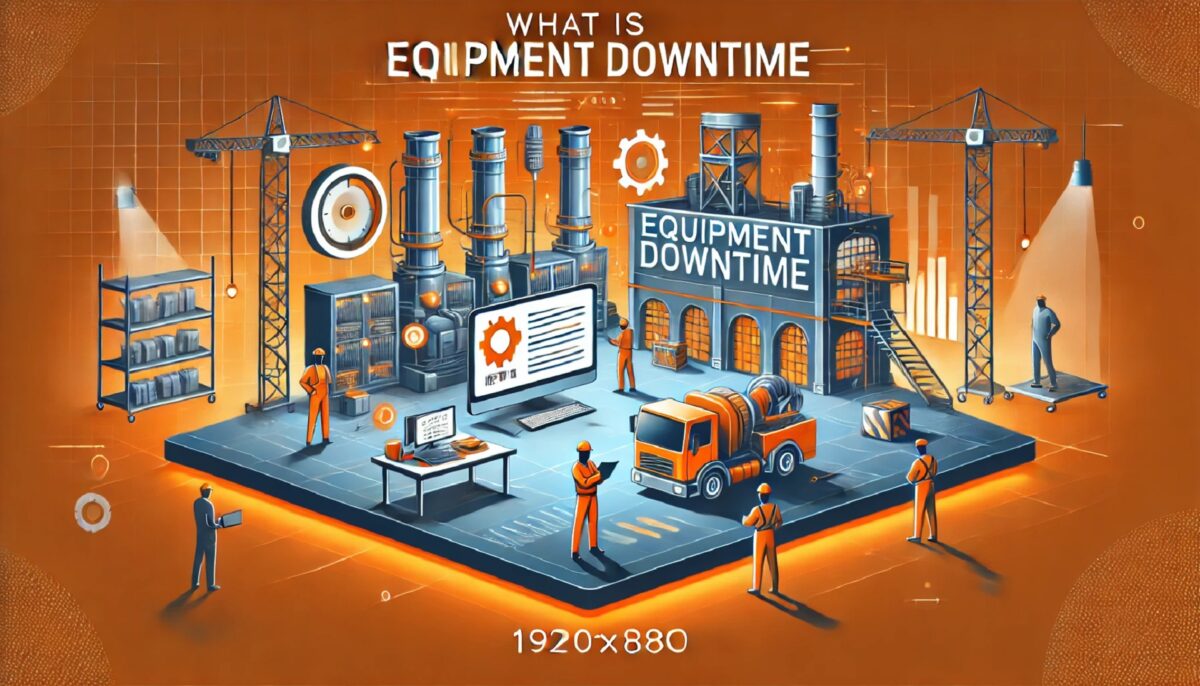Introduction
In every industrial and manufacturing setup, equipment downtime is an unavoidable yet critical factor that can determine the efficiency, profitability, and overall productivity of operations. Equipment downtime refers to the period during which machinery or equipment is unavailable for use due to failure, maintenance, or other issues. This can lead to significant operational disruptions, unplanned costs, and missed production targets.
In the Indian context, where industries like manufacturing, textiles, automotive, and infrastructure play a pivotal role in the economy, equipment downtime management has become increasingly essential. Given India’s growing push towards “Make in India” and a vision for a $5 trillion economy, reducing downtime and improving equipment efficiency is vital for sustaining industrial competitiveness.
This blog will delve into the concept of what is equipment downtime, its various types, causes, and consequences, along with strategies to manage and reduce it effectively, with special attention to the Indian industrial landscape.
What is Equipment Downtime?
Definition and Breakdown
Equipment downtime refers to the time during which a machine or system is not operational or available for use due to maintenance, breakdown, or other interruptions. Downtime can be categorized into two main types:
- Planned Downtime:
- Occurs due to scheduled maintenance, upgrades, or necessary adjustments to the equipment.
- Examples include routine servicing, inspections, or upgrades to improve performance.
- Unplanned Downtime:
- Refers to unexpected breakdowns or malfunctions.
- This is often more detrimental as it disrupts production flow without prior warning, leading to production losses and repair costs.
Types of Equipment Downtime:
Identifying the Causes
Mechanical Failures:
These are the most common forms of downtime and occur when a component of the equipment breaks or malfunctions. In India, particularly in older industries, outdated machinery can frequently break down, leading to high unplanned downtime.
Operational Errors:
Human error in operation, lack of training, or improper handling of equipment can also lead to downtime. Many Indian SMEs (small and medium enterprises) suffer from downtime due to inadequate operator training.
Maintenance and Repairs:
While maintenance is necessary to keep equipment functioning, poorly planned maintenance schedules or delayed repairs can increase downtime. Maintenance-related downtime can be reduced with predictive and preventive maintenance strategies.
Supply Chain Delays:
Lack of timely availability of spare parts is a frequent issue in India, especially in sectors like agriculture and mining, where specialized parts are often imported. Delays in the supply chain can lead to prolonged equipment downtime.
Power Outages:
In India, power reliability is still a challenge in many regions, particularly in rural and industrial belts, causing equipment to remain inactive for extended periods. Companies are increasingly turning to backup solutions like generators or renewable energy sources to combat this.
Consequences of Equipment Downtime:
Impact on Businesses
Loss of Productivity:
Equipment downtime directly affects production capacity. Even a brief disruption can lead to cascading delays in the production cycle. In industries like automotive manufacturing, where assembly lines depend on each process being completed on time, downtime can lead to significant production losses.
Financial Losses:
Unplanned downtime can incur substantial financial losses due to both lost production and the cost of repairs. For example, in India’s textile sector, a machine malfunction can halt production, leading to missed delivery deadlines and loss of revenue.
Damage to Equipment:
Frequent and prolonged downtime can cause wear and tear on equipment, further reducing its lifespan and leading to higher maintenance and replacement costs.
Customer Dissatisfaction:
When downtime affects the production and delivery schedule, it can lead to delays in fulfilling customer orders, impacting customer trust and loyalty.
Safety Risks:
Equipment failure can pose significant safety hazards to workers. Downtime caused by equipment breakdowns can sometimes result in accidents, especially in industries like construction and mining.
Equipment Downtime in the Indian Context:
Sector-Specific Insights
Manufacturing Sector:
In India, the manufacturing sector is a major contributor to GDP, with industries like automotive, textiles, and electronics playing a central role. According to a report by the Confederation of Indian Industry (CII), equipment downtime in Indian manufacturing plants can result in production losses of up to 20%.
Agriculture:
Agriculture in India is heavily reliant on machinery such as tractors, harvesters, and irrigation systems. Equipment downtime during peak farming seasons can be particularly costly, affecting crop yields and farmer income. With increased adoption of mechanization, downtime management is becoming more critical in this sector.
Infrastructure Development:
India is seeing rapid growth in infrastructure projects, from highways to railways. Equipment used in construction, such as cranes, excavators, and concrete mixers, is prone to downtime due to harsh operating conditions, lack of timely maintenance, and supply chain issues for spare parts.
Mining Industry:
Mining is another critical sector in India, contributing to both exports and the domestic economy. Downtime in this sector, caused by equipment failure or delays in receiving mining machinery parts, can halt operations, leading to significant revenue loss.
Strategies for Reducing Equipment Downtime:
Proactive Approaches to Maintenance
Preventive Maintenance:
Scheduled maintenance can prevent unplanned downtime. Indian industries are increasingly adopting preventive maintenance techniques, leveraging technologies such as IoT (Internet of Things) to monitor equipment health and schedule timely repairs.
Predictive Maintenance:
By using data analytics and sensors, predictive maintenance allows companies to predict when equipment is likely to fail. This minimizes downtime by ensuring repairs are carried out before the equipment breaks down. The rise of Industry 4.0 in India is driving the adoption of these smart maintenance techniques.
Training and Workforce Development:
Proper operator training is crucial to minimizing human errors that lead to equipment downtime. In India, where there is a shortage of skilled labor in certain industries, companies are increasingly investing in training programs to upskill their workers.
Spare Parts Management:
Ensuring the timely availability of spare parts is critical for reducing downtime. Companies can adopt just-in-time inventory systems to maintain optimal stock levels of critical components.
Improved Power Infrastructure:
As India modernizes its power infrastructure and adopts renewable energy sources, industrial sectors are seeing fewer power-related downtimes. Government initiatives like the National Smart Grid Mission (NSGM) are contributing to this reduction.
Technology’s Role in Reducing Equipment Downtime:
The Rise of Smart Manufacturing in India
IoT and Industry 4.0:
The integration of IoT devices and Industry 4.0 technologies in Indian industries allows real-time monitoring of equipment health, helping businesses predict breakdowns and address them before they lead to downtime.
Automation and Robotics:
The use of automation and robotics is gaining momentum in Indian factories. Automated systems can operate continuously without human intervention, reducing downtime caused by manual errors.
Cloud-Based Maintenance Software:
Cloud-based CMMS (Computerized Maintenance Management System) platforms are increasingly being used in India. These systems help manage maintenance schedules, track equipment health, and log downtime events, making it easier for companies to reduce unplanned downtime.
Case Study: Equipment Downtime in an Indian Manufacturing Plant
(Example Scenario)
A prominent automotive manufacturing company in India recently implemented a predictive maintenance system using IoT sensors to monitor the performance of their critical machinery. Before the implementation, the company faced frequent unplanned downtime due to equipment failures, costing them several lakhs of rupees in production losses each month.
With the new system in place, the company reduced its unplanned downtime by 30% within the first year. Sensors alerted operators of potential issues before they escalated, allowing timely intervention and repairs. As a result, the plant saw a significant increase in overall equipment effectiveness (OEE), contributing to higher productivity and profits.
Conclusion:
The Way Forward for Indian Industries
Equipment downtime is a significant challenge for industries across the globe, but in India, it presents unique challenges due to infrastructural and logistical hurdles. However, with advancements in technology, better training, and a more proactive approach to maintenance, Indian industries can reduce downtime and enhance productivity.
The adoption of smart manufacturing, predictive maintenance, and proper spare parts management are some of the key strategies that can help Indian companies stay competitive in a rapidly evolving global market.
Managing equipment downtime effectively is not just about maintaining profitability; it’s also about ensuring safety, sustainability, and long-term growth in an industrial economy like India’s.
Call to Action:
If you’re looking to reduce equipment downtime in your facility, adopting advanced maintenance techniques and leveraging new technologies like IoT can significantly enhance your operations. Get in touch with experts to help you implement the right solutions for your business.








